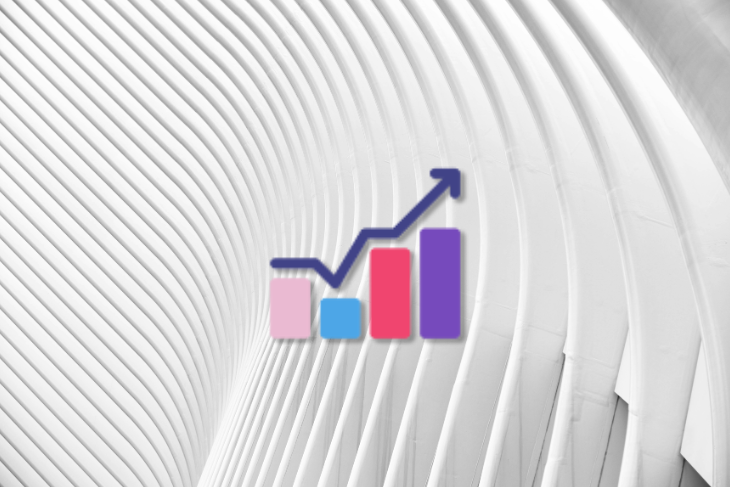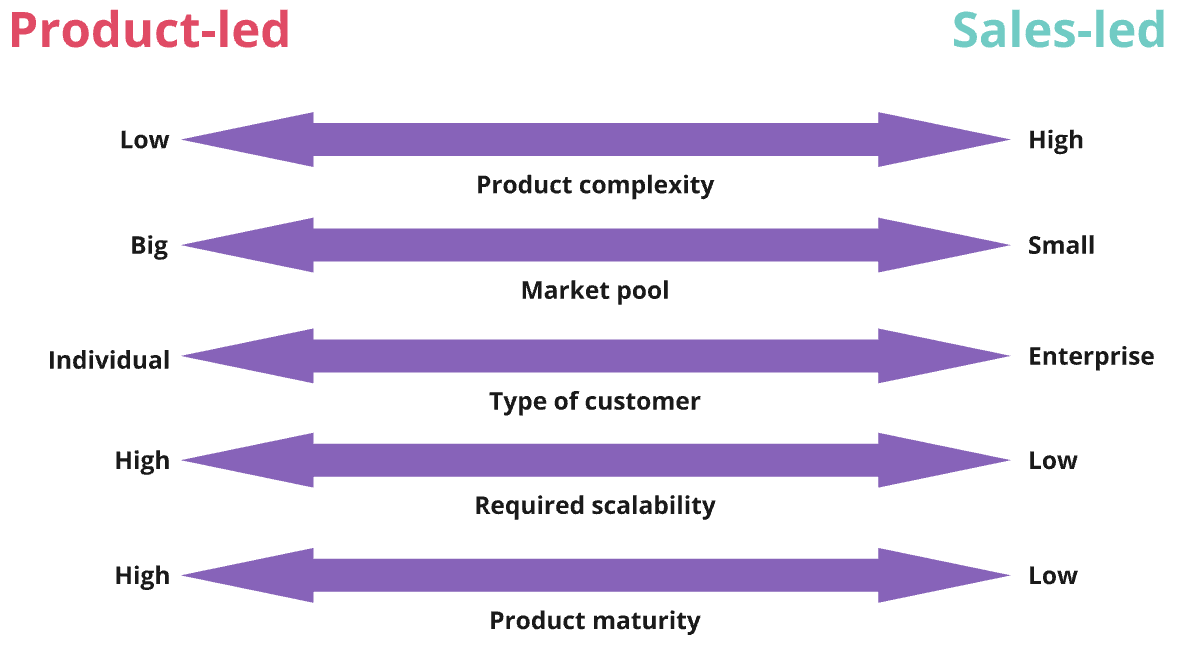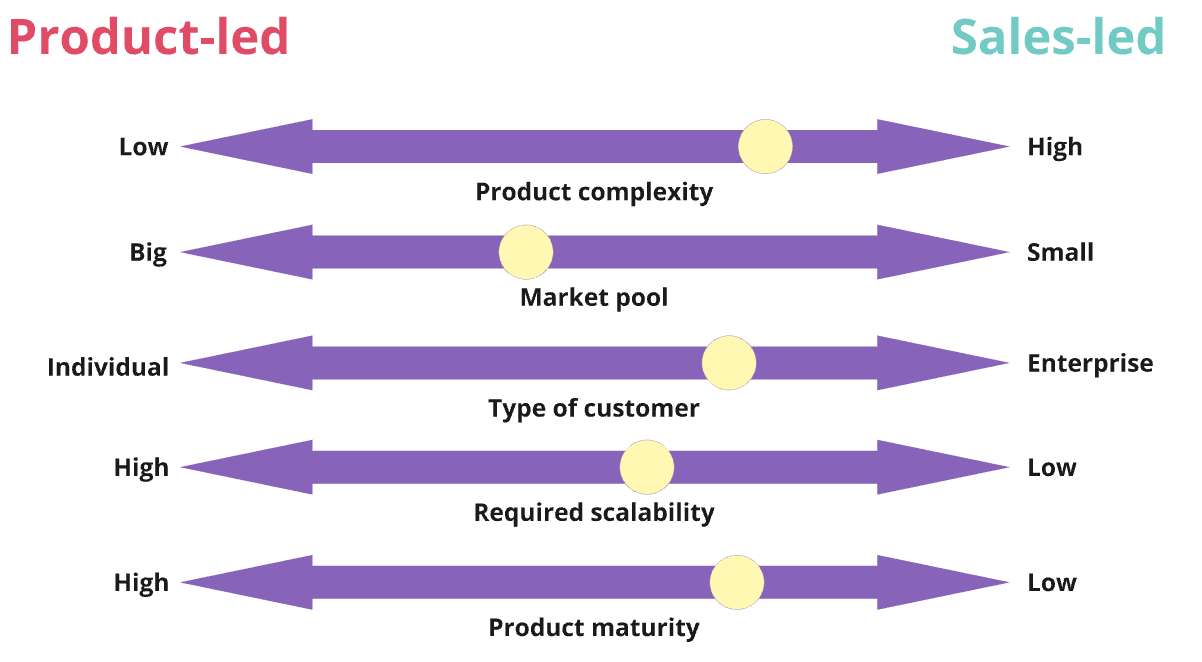It doesn’t matter how amazing your product is if no one knows it exists.

That’s why your growth strategy is as important (or maybe even more important) as your product strategy itself.
While there are many different growth channels and tactics, two tend to be the most common customer acquisition:
This article explores them in greater depth, examining how they differ and, most importantly, how to choose the right approach.
Product-led growth, or PLG for short, is a growth strategy where the product itself is the main source of customer acquisition.
Instead of directly selling or convincing anyone to pay for the product, you expose them to it (organically or through ads) and let them experience it for free.
The most common PLG motions include:
When designing the product, PLG companies focus on streamlined onboarding, clarity of value proposition, and upsell nudges that encourage users to upgrade on their own without the need to contact anyone.
Sales-led growth is an acquisition strategy focusing on direct interactions with prospective buyers. It can happen in two ways:
The product doesn’t need to handhold users as much since salespeople and customer service representatives do the heavy lifting regarding onboarding and learning how to use the product.
However, the product must be a truly premium service or offer a complete solution to a complex problem. Sales teams are expensive, so the product must be expensive enough to justify it.
When it comes to PGL and SLG, the key differences include:
| Area | Product-led growth | Sales-led growth |
| Growth driver | Product experience | Sales team effort |
| Acquisition medium | Freemium, trials, sandbox | Direct calls, demo sessions |
| Target audience | Individual users, SMBs | Enterprises, high-value individuals |
| Buying process | Low-touch, self-directed | High-touch, sales-assisted |
| Customer relationship | Focused on delivering product value through intuitive UX | Focused on building relationships and providing tailored guidance |
| Onboarding | Self-serve, product-led onboarding | High-touch, guided onboarding |
Product-led growth is all about the product experience doing all the heavy lifting in converting prospects to buyers, while sales-led growth uses sales interactions to achieve that.
Freemium, free trials, and sandbox experiences are primary ways for users to learn about and get hooked on the product in PLG motions. Sales-led growth focuses on direct outreach calls and offering free demos to pitch the product.
Sales teams are expensive, so the product also has to be expensive. For this reason, sales-led products often target bigger enterprises or high-value clients to break even. PLG, on the other hand, is well-suited to attract mass markets, including both individuals and small and medium businesses.
In PLG, the sales happen within the product itself. Users usually need to click an upgrade button and insert their CC details, and they’re all set. Sales-led products are usually more expensive and require directed, high-touch service, including contract negotiations and so on.
Since there’s no direct interaction with customers in product-led motions, the customer relationship focuses mostly on delivering a great user experience that makes users want to return. On the other hand, sales-led products focus on building lasting relationships between companies and even customizing the service if needed.
Onboarding is fully self-served with PLG products. Sales-led growth on the other hand, provides guided onboarding, which can last a couple of months for more complex products.
As you can probably already see, PLG has a lot of advantages and challenges. One most impact ones include:
Compared to an expensive sales team, PLG is extremely cheap. In most cases, the two main costs are:
A well-thought-through PLG funnel scales easily. It doesn’t matter if 10 or 10,000 customers go into the funnel. The onboarding and upgrade flow works the same way. There’s no need to hire additional people or work extra time to cater for higher demand.
Having a product that sells itself is easier said than done. Getting the product and UX right requires a lot of upfront investment, and it might even be impossible to achieve in the case of more complex products.
PLG products have significantly lower conversion rates and sales-led products, so they must rely on a scale. You must either be extremely efficient with performance marketing actions or achieve high virality to become a unicorn with PLG motion.
Sales-led growth comes with its own set of powerful advantages and challenging cons. These include:
Sales-led products are usually quite expensive (that’s why you need a sales team to explain the value!), meaning you can earn as much from a single customer as a PLG product would earn from thousands of them.
Customer retention is quite high, mainly due to the high upfront commitment required for complex products and the ability to approach each customer individually. You can build an extremely successful sales-led product with as few as ten paying customers.
Hiring salespeople, training them, and waiting until they find and sign leads is an expensive process. Not only are you forced to charge high prices for your product, but you also need a significant initial investment to get the ball rolling.
Whenever you want to scale your growth effort, you need to:
It takes time, which can significantly slow down your growth.
Scaling down is even more challenging. You might not plan for it, but the market might force you to slow down occasionally. Then, you’re faced with a tough decision to either maintain high overhead or lay off some of your people.
The decision to go product- or sales-led has such a tremendous impact not only on the product itself, but also on your company. Make sure to review these factors:

You can use the graphic above to assess which model works better for you. For each criterion, put a dot closer to the left or right side, depending on how you assess the criteria:

For example, if most of the dots indicate a sales-led approach, that’s a good indicator that this motion might be right for you.
Both product-led and sales-led growth models have merit.
Product-led growth products excel at attracting the masses and acquiring customers cheaply. Sales-led products excel at selling even the most complex software and maximizing the revenue from every single customer.
To simplify it, I would say:
However, many more factors, such as product maturity, scalability requirements, and complexity, must be considered. You need to take a deeper look at your products and company characteristics.
If you are still unsure, run small experiments. Build a self-serve onboarding funnel and see how it performs while you try to sell the product directly yourself. Test both approaches to see which gives you more promising signals, and then double down on what works.
Featured image source: IconScout

LogRocket identifies friction points in the user experience so you can make informed decisions about product and design changes that must happen to hit your goals.
With LogRocket, you can understand the scope of the issues affecting your product and prioritize the changes that need to be made. LogRocket simplifies workflows by allowing Engineering, Product, UX, and Design teams to work from the same data as you, eliminating any confusion about what needs to be done.
Get your teams on the same page — try LogRocket today.

A practical guide for PMs who want to stop being bottlenecks, delegate smarter, and lead teams effectively with a clear ownership framework.

Stop letting unreliable data block features. Treat data as inventory to track quality, ownership, and ship with confidence.

Learn why slide decks slow teams down and explore better tools like whiteboards, PRDs, and prototypes to improve collaboration and alignment.

AI PM roles are evolving fast. Learn the five types of AI PMs, the skills they need, and how they shape AI products across industries.